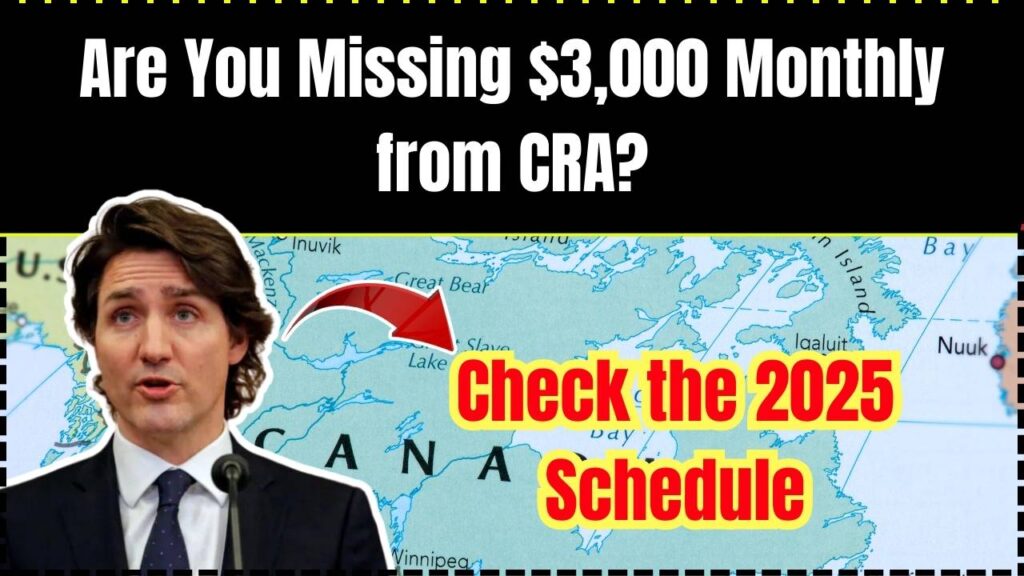
Are You Missing $3,000 Monthly from CRA: Many Canadians may not realize they could be eligible for up to $3,000 per month in financial support through a combination of Canada Revenue Agency (CRA) benefit programs. These benefits are designed to assist seniors, families, and low- to moderate-income individuals, offering a vital financial safety net in 2025.
Whether you’re a retiree, a working parent, or a low-income individual, understanding what’s available—and when payments are scheduled—can help you make the most of what you’re entitled to.
Are You Missing $3,000 Monthly from CRA?
| Benefit Program | Maximum Monthly Amount (2025) | Eligibility Criteria | Payment Dates (2025) |
|---|---|---|---|
| Canada Pension Plan (CPP) | Up to $1,433 | Canadians aged 60+ who contributed during working years | Monthly (e.g., April 28, 2025) |
| Old Age Security (OAS) | $727.67 (65–74), $800.44 (75+) | Canadians aged 65+ with 10+ years residency in Canada | Monthly (e.g., April 28, 2025) |
| Guaranteed Income Supplement | Up to $1,086.88 | Low-income seniors receiving OAS | Monthly (e.g., April 28, 2025) |
| Canada Child Benefit (CCB) | Up to $7,437/child annually | Families with children under 18; income-dependent | Monthly (e.g., April 17, 2025) |
| GST/HST Credit | Up to $992/year per family | Low- to modest-income individuals and families | Quarterly (e.g., April 4, 2025) |
| Ontario Trillium Benefit | Up to $1,421/year (seniors) | Ontario residents with eligible rent, energy, or tax expenses | Monthly (e.g., April 10, 2025) |
| Canada Carbon Rebate (CCR) | Varies by province and family size | Residents in provinces where federal carbon pricing applies | Quarterly (e.g., April 22, 2025) |
With the right combination of programs, Canadians—especially seniors, families, and lower-income individuals—can receive up to $3,000 per month in financial assistance. From CPP and OAS to CCB and the Carbon Rebate, these benefits offer essential support that helps many Canadians live more comfortably.
What Is the $3,000 Monthly CRA Payment?
The “$3,000 per month” isn’t a single government cheque—it’s the combined total of various federal and provincial benefit programs. If you’re eligible for several of these programs, especially if you’re a senior or a parent with young children, your monthly income from CRA-administered benefits could add up to or exceed $3,000.
Breaking Down the Main Benefits
Canada Pension Plan (CPP)
- Who Qualifies: Canadians aged 60+ who have made valid contributions during their working life.
- Amount: Up to $1,433/month in 2025.
- Good to Know: You can start receiving CPP as early as age 60 or delay it to increase your monthly amount.
Old Age Security (OAS)
- Who Qualifies: Canadians aged 65 or older with at least 10 years of residency after age 18.
- Amount: Up to $727.67/month for those aged 65–74 and $800.44/month for those 75+.
- Tip: Income affects your eligibility; higher-income seniors may have to repay some or all of their OAS through a “clawback.”
Guaranteed Income Supplement (GIS)
- Who Qualifies: Seniors receiving OAS with low annual incomes.
- Amount: Up to $1,086.88/month for single seniors.
- Extra Info: GIS is not taxable and is recalculated annually based on your income.
Additional Benefits You May Be Missing
Canada Child Benefit (CCB)
- Who Qualifies: Families with children under age 18.
- Amount: Up to $7,437 per year for each child under 6, or $6,275 for children aged 6–17.
- Monthly Help: This means over $600 per month per child if you’re eligible for the full amount.
GST/HST Credit
- Who Qualifies: Low- to moderate-income individuals and families.
- Amount: Up to $496/year for single individuals or $992/year for couples with children.
- Payment Schedule: Issued every three months.
Ontario Trillium Benefit (OTB)
- Who Qualifies: Ontario residents who qualify for the energy credit, property tax credit, or sales tax credit.
- Amount: Up to $1,421 per year for seniors.
- Payment Frequency: Monthly, making it easier to budget.
Canada Carbon Rebate (CCR)
- Who Qualifies: Residents in provinces where federal carbon pricing applies.
- Amount: Varies by province and household size.
- Schedule: Paid every quarter and adjusted based on family size and location.
How to Ensure You Don’t Miss Out
Even if you’re eligible, you may not automatically receive some of these payments. Here’s how to stay proactive:
File Your Taxes Every Year
- Even if you have no income, filing ensures the CRA can assess your eligibility for benefits like the GST/HST Credit and GIS.
Update Your Personal Information
- Always notify CRA about changes in your address, marital status, or number of children.
Apply for Benefits Where Required
- While some benefits like OAS are automatic, others (like GIS or CCB) require an application.
Verizon Lawsuit Settlement Confirmed – See How Much You’ll Get and When!
Singapore’s $2,250 April Cash Boost Is Here – Find Out If You’re Eligible Now!
FAQs about Are You Missing $3,000 Monthly from CRA?
Can I receive both CPP and OAS at the same time?
Yes, you can. CPP is based on your work history, while OAS is residency-based. Most seniors receive both.
Is the $3,000 a guaranteed payment?
No. It’s a potential combined total from multiple CRA programs if you meet the specific criteria for each.
Do I need to reapply for benefits each year?
Some benefits renew automatically, but others (like GIS) may require reapplication or updated information each year.
What happens if my income increases?
Your eligibility for income-tested benefits like GIS or GST/HST Credit may change. These are recalculated yearly based on your income tax return.










